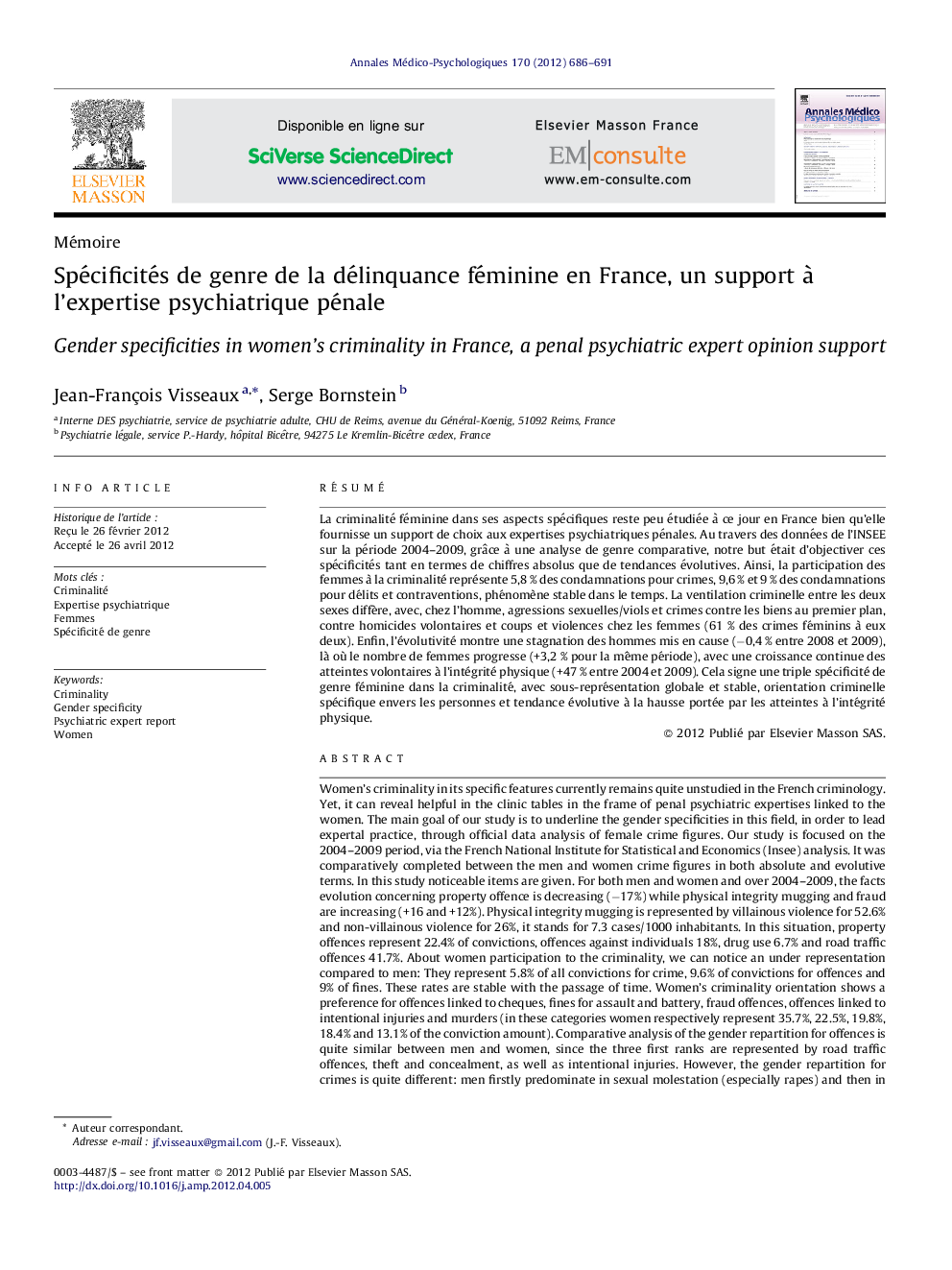| کد مقاله | کد نشریه | سال انتشار | مقاله انگلیسی | نسخه تمام متن |
|---|---|---|---|---|
| 314909 | 535478 | 2012 | 6 صفحه PDF | دانلود رایگان |

RésuméLa criminalité féminine dans ses aspects spécifiques reste peu étudiée à ce jour en France bien qu’elle fournisse un support de choix aux expertises psychiatriques pénales. Au travers des données de l’INSEE sur la période 2004–2009, grâce à une analyse de genre comparative, notre but était d’objectiver ces spécificités tant en termes de chiffres absolus que de tendances évolutives. Ainsi, la participation des femmes à la criminalité représente 5,8 % des condamnations pour crimes, 9,6 % et 9 % des condamnations pour délits et contraventions, phénomène stable dans le temps. La ventilation criminelle entre les deux sexes diffère, avec, chez l’homme, agressions sexuelles/viols et crimes contre les biens au premier plan, contre homicides volontaires et coups et violences chez les femmes (61 % des crimes féminins à eux deux). Enfin, l’évolutivité montre une stagnation des hommes mis en cause (−0,4 % entre 2008 et 2009), là où le nombre de femmes progresse (+3,2 % pour la même période), avec une croissance continue des atteintes volontaires à l’intégrité physique (+47 % entre 2004 et 2009). Cela signe une triple spécificité de genre féminine dans la criminalité, avec sous-représentation globale et stable, orientation criminelle spécifique envers les personnes et tendance évolutive à la hausse portée par les atteintes à l’intégrité physique.
Women's criminality in its specific features currently remains quite unstudied in the French criminology. Yet, it can reveal helpful in the clinic tables in the frame of penal psychiatric expertises linked to the women. The main goal of our study is to underline the gender specificities in this field, in order to lead expertal practice, through official data analysis of female crime figures. Our study is focused on the 2004–2009 period, via the French National Institute for Statistical and Economics (Insee) analysis. It was comparatively completed between the men and women crime figures in both absolute and evolutive terms. In this study noticeable items are given. For both men and women and over 2004–2009, the facts evolution concerning property offence is decreasing (−17%) while physical integrity mugging and fraud are increasing (+16 and +12%). Physical integrity mugging is represented by villainous violence for 52.6% and non-villainous violence for 26%, it stands for 7.3 cases/1000 inhabitants. In this situation, property offences represent 22.4% of convictions, offences against individuals 18%, drug use 6.7% and road traffic offences 41.7%. About women participation to the criminality, we can notice an under representation compared to men: They represent 5.8% of all convictions for crime, 9.6% of convictions for offences and 9% of fines. These rates are stable with the passage of time. Women's criminality orientation shows a preference for offences linked to cheques, fines for assault and battery, fraud offences, offences linked to intentional injuries and murders (in these categories women respectively represent 35.7%, 22.5%, 19.8%, 18.4% and 13.1% of the conviction amount). Comparative analysis of the gender repartition for offences is quite similar between men and women, since the three first ranks are represented by road traffic offences, theft and concealment, as well as intentional injuries. However, the gender repartition for crimes is quite different: men firstly predominate in sexual molestation (especially rapes) and then in property offences, whereas women are over represented in murder then in assault and battery (61% of all women's crimes with these two items included). Nowadays, this specificity in women's criminality orientation and repartition is based on sociologic models, which are lauding women's social isolation and differencial sociabilisation between both genders (instead of former psychological or physiological theories). Crime's scability shows another gender specificity: the number of female involvement is consistently increasing (+15.5% between 2004–2009 and +3.2% between 2008–2009), while at the same period and for the first time, the number of male involvement is decreasing (−0.4% between 2008–2009). This increase is mainly linked to property offence, physical integrity mugging and frauds (respectively +7.4%, +6.2% and +4% between 2008–2009). Moreover, physical integrity mugging increase of 47% between 2004–2009. Conversively, drug use is decreasing inside women criminality (−3.8% for the same period). Eventually, it has to be noticed that imprisoned women represent only 3.1% of the prison population in 2009 (this rate keeps quite similar year in year out). The decrease of the rate of women concerned throughout the criminal justice process (15% of court implicated individuals, 10% of convictions, 3% of prison population) might let us think to some leniency from justice and police institutions towards them. However, some major variables need to be considered, as a bigger resistance to recidivism: in 2009 women only represented 5% of repeated offences and 1% of repeated crimes, the outcome of an improved sensibility to penal sanctions compared to men. Therefore a triple gender specificity concerning women's criminality comes up: a global and stable under representation, a specific criminal orientation against individuals, and an upward trend carried by physical integrity mugging.
Journal: Annales Médico-psychologiques, revue psychiatrique - Volume 170, Issue 10, December 2012, Pages 686–691